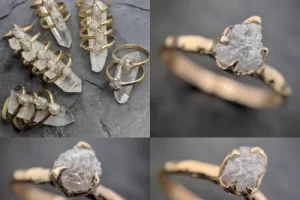Raw diamonds, also called rough diamonds, refer to diamonds that have not been processed, cut, polished, etc., including diamonds that have just been mined from the mine. They are also called rough diamonds (raw diamonds). These diamonds are similar to those found in jewelry stores. The diamonds you receive are completely different. The original diamonds are more of an opaque and hazy metallic texture, irregular shapes and dull luster, which are in sharp contrast to the processed diamonds.
Cut diamonds can usually be detected with instruments, but not necessarily raw diamonds. So how do we identify a raw diamond when we encounter it? Follow this guide to learn about and identify raw diamonds (rough diamonds)
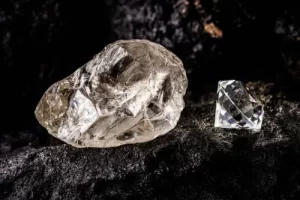
Key Points:1. Raw diamonds have unique and not unique crystal and appearance structures before being processed.
2. Mastering the physical properties and appearance characteristics of original diamonds is the basis for identification.
3. The rise of artificial diamonds has made identification more difficult
4. There are many identification methods and they need to be used in reasonable combination.
Basics of Rough Diamonds
Formation: The most common view of rough diamonds is that they are pure carbon crystals formed deep in the earth’s mantle under the extreme pressure and temperature of the earth’s interior.
Appearance: They are in an undiscovered natural state, with a dull appearance, similar to frosted glass. They are irregular in shape in nature, so they will not shine like processed diamonds. Moreover, raw diamonds come in many colors after being mined, including transparent, light yellow, green, brown, and even black. Unless they are mined in a specialized diamond mine, it is difficult to identify whether they are genuine diamonds. diamond.
Value: Perfect, high-quality raw diamonds are very rare. The price of a raw diamond depends on its weight, color, uncut clarity and potential value after cutting. Since raw diamonds need to be professionally cut and polished before entering the market, the price is generally cheaper than cut diamonds.
Application: Raw diamonds with good appearance will be flowed into the jewelry market, while those with low appearance grade will be used for industrial purposes, such as cutting tools, drill bits, etc.
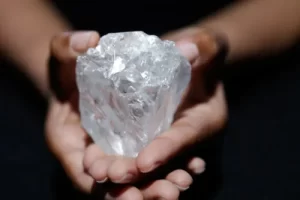
How to identify raw diamonds
Hardness test: Diamond is the hardest material in nature. The easiest way is to scratch a piece of glass with a diamond. If there are scratches on the glass but not on the diamond, then it may be a diamond. This method is not a complete identification, as other stones can also leave scratches on the glass.
Check the appearance: octahedron or dodecahedron, with various and non-repeating colors, and the surface is hazy and dull.
Water test: The density of diamonds is very high. If you put it in a glass of water, it will sink. If it does not sink completely, it is not a diamond. The density of diamond is 3.47-3.55g/cm3, with an average of 3.52g/cm3. Using the hydrostatic method and using carbon tetrachloride as the medium, the measurement value will be more accurate.
Transparency: Place the stone on a piece of paper with text. If the text can be seen clearly through the stone, it cannot be a diamond. The crystal structure inside the diamond will refract light and cannot be seen directly through the diamond.
Fog test: Breathe into the stone and watch how quickly the fog dissipates. Diamonds dissipate heat quickly, so the fog disappears almost immediately.
Magnifying observation: Use a magnifying glass to observe internal flaws. Most natural diamonds contain inclusions. You can also use a high-power magnifying glass, or a microscope if possible, to look for the tiny triangular edges inside the stone, and to look for whether the flaws are small bubbles. Diamonds with these characteristics are basically the same as original diamonds.
Thermal conductivity meter: Diamonds have good thermal conductivity. Thermal conductivity meter can be used to detect the authenticity of original diamonds. This is the common diamond testing pen in the jewelry market. This kind of detection is the most accurate and basically has no problems, because different stones with exactly the same physical properties have not yet been discovered (except for artificial laboratory diamonds), and the thermal conductivity of diamonds is different. Stones with different rates can basically be concluded as not original diamonds.
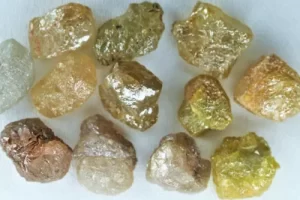
Other gemstones similar to the original diamond
Quartz: Particularly clear quartz, whose crystal structure results in an appearance that is very similar to raw diamonds and can sometimes be mistaken for diamonds. Unlike diamond, quartz is less hard and has a different refractive index.
Topaz: Clear and white topaz may be mistaken for rough diamonds.
White Sapphire: Similar in appearance to raw diamonds, it is often used as a diamond substitute in jewelry. White sapphires are hard and contain fewer inclusions.
Moissanite: This is another gemstone that is very similar to diamonds. It is also used as a substitute for diamonds or even surpasses diamonds. Moissanite is almost as hard as diamonds, and its fire is higher and more sparkling than diamonds. , it will also show rainbow light in the sunlight.
Zircon: Not to be confused with cubic zirconia, natural zircon may resemble a rough diamond. It is softer (compared to diamonds, which are physically very hard) and is a birefringent mineral (meaning it bends light twice as it passes through the stone, which is not seen in diamonds) Effect).
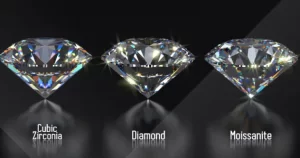
FAQs
How to distinguish rough diamonds from quartz?
1. The crystal shapes are different, diamond is octahedron or dodecahedron, and quartz is hexagonal prism shape. 2. The refractive index is different, the refractive index of diamond is higher, if you put quartz on the text, you can see the text through the quartz. 3. Thermal conductivity is different. Diamond has very good thermal conductivity. A diamond tester that measures thermal conductivity can easily distinguish original
Diamond and quartz.What are the most common colors of raw diamonds?
The most common colors of raw (or rough) diamonds are yellow and brown. Rough diamonds have also existed in colorless forms, but they are not commonly found in nature.
Are there any portable tools that can identify rough diamonds in the field?
Diamond tester (thermal pen): Rough diamond has excellent thermal conductivity, so its thermal conductivity is an important reference data for distinguishing other stones.
Polarizer: A polarizer can help determine the optical properties of a gemstone.
How does the value of a raw diamond compare to a cut diamond?
Unless it is an extremely rare raw diamond, the price is basically lower than that of cut diamonds, because the cutting weight loss of rough diamonds may be as high as more than 50%, so the price is difficult to exceed that of cut diamonds.
Can rough diamonds be used in engagement rings?
Of course, some people like the special haziness of raw diamonds.
